
BELIEVE YOU CAN MAKE A DIFFERENCE AND YOU WILL!
Main Article
Digital sexual harassment: the hindrance for a digital Bangladesh
Sheepa Hafiza, Equality & human rights activist and social analyst
Classmates forcibly took some sexually offensive pictures and videos and spread them on the Internet of a high school student of class 10 name R, commit suicide to get rid of the humiliation and mental torture. R is not alone. Girls, women, boys and men and persons with diversified sex of all age, socio-economic status and professions, including media stars have become victims of the spread of offensive pictures and videos on the Internet.
A few days ago, I saw in a daily newspaper that such a demonic incident happened in the life of a schoolgirl in B Upazila of a district. The girl was raped by her ex-boyfriend and six accomplices and filmed on mobile phones. Later he spread that video in the form of CD in the market. It is known that the boy did the act out of revenge as the girl refused to continue with him as friend. Although the girl's father filed a case under the Prevention of Violence against Women and Children Act, the main accused has not yet been caught.
As per the statement of the human rights lawyer there are many cases filed where the husband blackmailed wife by threatening to spread offensive videos on the Internet if she did not bring money from her father's house, or do wrongful things as his wish. A case has been filed in court regarding this. Many are facing this dire situation and are choosing to commit suicide. Indecent images were sometimes forcibly captured. Sometimes, the photos taken by compromise while in a good
relationship are later spread on the internet as a tool for 'blackmail'. There are false photos made with photograph manipulation, meaning involves the transformation or alteration of a photograph using various methods and techniques to achieve desired results.
Girls and young generations are the major victim, however women men of any age and the boys are also victims of this sexual harassment through use of insecure cyberspace. More recently in District A, a video about sexual nature was released in the market involving a woman and man staff of a private organization. Citing the so-called video footage, a report was published in local newspaper with hate speech against the staff and the NGO. The local office of the administration along with the local people expressed strong reactions against the woman and her work place. They closed the NGO office and dismissed the accused women worker and ordered them to leave the area without any investigation or fact-checking. However, with a special request from the NGO head office in Dhaka the law enforcing authority reassured the agitated mob who were about to set on fire the office. Further, did a fact-findings investigation. After watching the video with an investigative mind, it can be seen that there is no similarity between the alleged NGO worker and the woman presented in the video. This was a false allegation. After hearing an incident based on speculation in a commercial video footage without verification why it was decided to close the NGO office and evict the woman worker from the area, the concerned NGO asked in the meeting with the administration and journalists. But no one could answer this question. This is the view of educated & responsible people of our society in the twenty-first century! Later the newspaper expressed regret, but the accused woman worker had to face a dire situation. The women, plagued by
everyone's gossip and questions, finally had to leave her job and hide herself form the onlookers.
There is no end to the oppressor class inventing methods to oppress women. If we keep our eyes and ears open, we can get to know about new types of violence against women. The latest form of violence against women is abuse through misuse of technology.
These incidents represent cyber-sexual harassment, is a form of sex-oriented harassment that uses the electronic media for targeting victims. Mobile internet etc. are being used in this work. It proliferated enormously in recent years among the younger generation in keeping with rapid expansion of unsafe use of online platforms. And like gender based violence and early and forced marriage, cyber-sexual harassment of women has also exacerbated during the Covid-19 pandemic.
Cyber harassment can take manifold forms such as uploading an embarrassing photo, video of someone online or texting someone threatening or abusive words. Most often the video and photos can be made falsely by any unauthorized person – young and old. According to the Cyber Crime Division of Dhaka, 80% of victims of online harassment are women among which the majority victims are of adolescent age.
As per ActionAid Bangladesh’s online research study of 2022, out of every 100 women in Bangladesh 64 have to face online harassment and violence in some form. They faced online violence 1 to 10+ times. This percentage is higher from the
prevalence rate of 2021 was 50 percent. Furthermore, most of the women faced online violence on Facebook (47%). Other platforms where women faced online violence were Messenger, Instagram, IMO, WhatsApp, YouTube, TikTok, LinkedIn, Google, Blog, Phone, Telegram, Skype, Viber, and Quora.
Perpetrators use technology intentionally to place false stigmas on girls & women to harass them. Majority of parents, teachers, friends, supervisors of workplaces are not knowledgeable or informed the manipulation of technology. They get worried and upset when they hear about the publication of any sexually oriented picture or video of their loved ones. As there is lack of ways or know how’s to investigate the allegation. They become very frightened & helpless, most often put doubts on the young girl’s conduct. This is a patriarchal cultural issue of the society who blame the innocent girls for the cause that they were not responsible for. In fact, the representatives of the patriarchal society never look at the person in whose name the responsibility is being imposed is she at all guilty or not. In many cases, by using photoshop or video editor, a woman's face is changed in various nude pictures and videos and the face of someone known is being harassed. The victim received lewd, offensive, sexual, or hateful comments. As a result of violence against women using technology, women are also socially degraded along with mental torture. In many cases, victims of cybercrime are unknowingly getting involved in pornography. Incidents of violence against women through misuse of technology are increasing. I believe such incidents are not limited to the cities and suburbs only, it already spread to the remotest areas as well. Cybercrime has added a new level of violence against women in the society like dowry, kidnapping, acid throwing, rape, abduction, trafficking of women. It has been seen that the image or video image of a girl is taken
tactfully and spread from mobile to mobile through messages, internet or through social media etc. The types of violence against women through cybercrime includes displaying obscene pictures publicly, sending threats through e-mails, sharing videos of private matters by close friends or acquaintances, opening new addresses on social media platform, adding new pictures and images etc.
Those who are active in this crime are very cleverly & wrongly trying to push the girl & women into darkness of mental state, either out of revenge or it can be done only for having fun. Often some of them do it without realizing the consequence to the victim’s life. Attacked parsons face fear of strong social stigma, victim blaming and privacy loss, a total loss of own confidence. As reliable data on the effect of cyber sexual harassment on victims are not available with us in this very sensitive issue, the severity of the situation is difficult to express or realize. We can only learn from the study of few developed countries that the suicidal rates are very high among this group of victims.
If we are not aware of the increasing incidents of sexual harassment against women using technology, there will have a risk of danger in the future.
Torture in the dictionary means to inflict physical or mental torture or ill-treatment or to cause pain, suffering or distress. But the term 'violence against women' is broader than its dictionary definition. Violence against women is the physical or mental abuse of a woman using force or violence on her body and mind. More specifically, it can be said that those misbehavior actions of men and women towards women are considered as violence against women, which does not allow a woman to be valued
as a human being and do not recognize her freedom of will or consent, nullify the natural movement, relationships and development of her body and mind and through which a woman directly or indirectly suffers short or long term harm or her life is completely endangered.
Why is this violence and abuse rooted in the mindset of patriarchy? The desire to establish power and authority or control over women by using violence against women as a tool by men is mostly to maintain power and control over. In a patriarchal society, women are in a disadvantageous and less opportune position than men in many respects. So, men in a power-holding position deny women equal rights continuously they tried to abuse in various ways. Patriarchy has given birth to the mentality of not respecting the individuality of women by looking down on them and arbitrarily insults her in various ways.
This sick mentality sees women as objects of men's enjoyment and careless attention to their bodies and minds. At the root of any violence against women is the mentality of male dominance over women. The same mentality is at the root of specific forms of violence against women and girls such as posting offensive pictures, and cartoons, videos on the internet, social media etc. Through such violence, women's independence, right to choose and dislike, right to earn a living and right to live as an individual are denied. Men who has low self-esteem, and somehow feel useless to the family and society use the tool of patriarchy to hurt a woman's personality by exposing her sexuality in public. In this case they choose the technology.
Due to the availability of computer technology, many cyber centers are being developed all over the country. Especially school and college students are seen spending hours in cyber cafes many of them spend time chatting and watching porn websites. With the change of time, the development of information technology has also added a new dimension to women's violence. With the development of science, both its advantages and disadvantages are becoming apparent to people. As the internet has made life easier on one hand, mis-management and the mis-use of it has also brought extreme human disasters to the life of teenagers or women, mutual hatred, tension in relationships, jealousy, depression, divorce, loss of patience, mental breakdown, consumerist culture of seeing women as sexual objects, social degradation etc. are responsible for such crimes. The criminal does not have to suffer much to commit such a crime. because they can easily commit such crimes from anywhere in the world from being in a hidden place.
The government passed the Pornography Control Act-2012 in February 2012 to curb cyber crime. The Act has various punishments for the offenders, depending on the degree of the crime, with a maximum imprisonment of ten years. There is a provision that the state as well as the court can take cognizance of the offenses committed under this Act as cognizable and non-bailable offenses without complaint. According to the Pornography Control Act, a person who knowingly or unknowingly captures a video or film of a woman, man or child for the purpose of producing pornography can be punished with up to 7 years imprisonment and a fine of up to Tk. 2 lakhs. If a person defames or blackmails someone through pornography or attempts to do so, the judge can award imprisonment for a term of 2 to 5 years and further impose a
fine of Tk. 1 to 2 lakhs. The maximum penalty for producing and distributing child pornography is 10 years imprisonment and a fine of up to Tk. 5 lakhs.
But it is not enough to make laws, it is necessary to inform people and create awareness. Apart from creating awareness some criminals should be given exemplary punishment by bringing them under this law. If some are given severe and exemplary punishment too soon, the fear of punishment will deter criminals from committing such crimes. Bangladesh Computer Security Incident Response Team (BD-CSIRT) has been formed under Bangladesh Telecommunication Regulatory Commission (BTRC) as a government initiative to prevent cyber crime. This committee is working to detect cyber crime. Members of the Commission, representatives of mobile phone operators, Internet Service Providers, PSTNs, International Internet Gateways and Cyber Cafes have been placed in this group. Its website has also been launched. If you are a victim of any kind of cyber crime, you have to report it. Later BD-CSIRT authority will advise according to the problem.
Nowhere does she find solace in the fact that the women of our country remain silent despite being abused or are the reason to choose the path of suicide. Victims of cybercrime, women are often humiliated by family, workplace, educational institution, society and even the state. As a result, women do not protest in these cases, nor do they have the courage to protest. Because to be brave they have to suffer a lot. Society does not want to accept any protesting woman easily. Many times they don't even get support from family. As a result, it can be seen that if protesting or taking legal action then greater responsibility falls on women. Then she has to take the
responsibility of the family and the children. As a result, women are getting the punishment. Because of this, women silently endure the torture.
A woman who is a victim of such crime does not get much benefit even if she files a case. Due to procedural reasons, cases are handled at a very slow pace. The victims were disappointed. They are forced to compromise due to various reasons such as long lines, threats etc. As a result, criminals get away. The government needs to pay attention to these issues. To prevent such crimes, first of all it is necessary to develop morals and increase awareness of people. One hope of everyone now is that everyone including the law enforcement agencies of the country will be very aware and cooperate with each other to prevent social ills like cyber crime.
The laws which can be availed by victims of cyber harassment in Bangladesh include the Information and Communication Technology Act, 2006 (ICT Act); the Pornography Control Act, 2012 (PC Act); and the Digital Security Act, 2018 (DS Act). Section 63 of the ICT Act ensures punishment for disclosure of confidentiality and privacy with imprisonment or with a fine or both. Section 24 of the DS Act penalizes identity fraud and provides sanctions for it whereas section 25 protects a person from the transmission or publication of offensive, false or threatening information regarding them through any digital medium. Section 29 of the DS Act protects a victim against defamation. Finally, section 8 of the PC Act has made the possession, distribution or use of any sort of pornographic material illegal. It has also included sanction for blackmailing using such materials and distributing them using the internet. With the proper
implementation of all these laws, it is possible to ensure the safety of the people accessing the digital platforms.
There are laws and rules in Bangladesh for deterring it, and provisions for punishment are also quite stringent. Even then, the litigation process often turns out to be excessively long-drawn or cumbersome. Besides, dearth of awareness on the issue and slow-moving trials cum delivery of verdicts are still huge challenges.
The definition to understand sexual harassment is not updated and all inclusive in the direction of the High Court – 2009 and also it is not evident in all those three Acts in discussion above. Without clear understanding the severity of the offence would not be clear to the protector mind. Without a gender responsive law and judiciary system and practices in place, the gender based violence is not possible to reduce or eliminate.
Usage of National Emergency number is prominent It is notable that no data was found for the national helpline port of Center for Violence Against Women and Children (CVAWC). The Action Aid study reveals that 64.71% of women did not find any redressal or action against their submitted complaints.
Fearing loss of respect in the society, most of the women victims of this type of torture complain and do not agree to report later. The remaining who report cannot go far due to legal complications. However, to get out of this situation, the families of the victims need administrative, counselling, financial and logistical assistance, which is to be available to them incl
Our young generation is turning towards crime due to the availability of technology, with absence of social & cultural involvement, active club. It is the responsibility of the state to protect them from this depressing situation involving the society and especially the family. The role of Families along with the neighborhoods and educational institutions should also be educated and strengthened in addressing such crimes. The focus should be on parents & teachers’ education to keep an eye on kinds of websites that are harmful, what their boys are looking at or what kind of friends they are hanging out with.
In this digital arena it is not wise to keep away our children from the digital devices for fear of crime, rather it is high time to help them to use internet safely, which is possible.
In addition to social resistance, the culture of protest and reporting should be encouraged and mobilized against all these injustices, not to be silent. The shame of harassment needs to be on the societies shoulder who failed to create a safe environment of learning for their children not on the victim.
Media play very strong role to set mindsets of citizens, it should be used appropriately to prevent any kind of torture, disrespect and harassment against girls & women. Media personalities to be trained and informed adequately so that they are able to portray evidence-based media reporting on sexual harassment that can change the attitudes and behaviors that drive violence against women.
Persons of media I suggest the state should impose on all media a time or space allocation, be it electronic or print to engage in discussions/talk/writings about the
positive role of human being who are respectful to all girls and women. Mass media can play an important role in changing the negative attitudes of the public, especially men towards women. Media can organize regular programs and publications against women's violence, to increase mass awareness against it and end the silence on the issue. In order to create awareness and sensitization, successful examples of social protection and legal systems in dealing with violence against women should be highlighted in the media. Newspapers must be educated and sensitized so that reports of incidents of violence against women are not published in newspapers just for the sake of increasing the newspaper's circulation or to tickle people's minds. The positive and dignified position of women should be highlighted in the media. Women should not be seen as products, but positive aspects like women's strength, skills and struggle should be highlighted in the media. Teachers should also play a leading role in bringing back values among teenagers to stop any form of harassment and violence against women including cybercrime. At the same time gender sensitive education should be introduced to empower the students, education should be the important tool for empowering young girls and boys, where they should focus learning of ethics, values and respecting each other as equal. Effective discussions of gender justice & human rights issues are not visible in most formal and non-formal education programs, especially at the primary and secondary levels. If these subjects are included in the curriculum and the teachers discuss the subjects in the classroom, the future citizens of the country will be aware of the dignity and respect of not only women but to self-dignity and responsibility. As a result, incidents of harassment in educational institutions and other areas will be reduced. Apart from this, special training/counseling should be provided to the youth of the rising age, so
that they learn to respect women as human beings as an equal and consider teasing or harassment as a shameful act and do not do such things themselves in future.
Lastly and very importantly children age from 7/8 should start learning use of internet with following all safety measures.
We need to believe that prevention is always better than cure. We have to take our role collectively to prevent such incidents from happening to those around us. Before that, we have to ensure that no woman is abused in our own homes, by our own hands. If each of us can make our own environment free from violence against women, then one day we can have a beautiful, prosperous country free from violence against women, whose momentum towards development will be unstoppable. The root cause of violence against women is not only the inferior and negative viewing of women as individuals, but the lack of collective social and political commitment against discrimination and violence against women is largely responsible for this. There is no alternative to collective initiative and socio-political commitment to uphold a safe digital connection for all.
It is mandatory to build safe cyberspace where everyone increases their access and use of it to realizing nation’s dream of safe, accessible, respectful and progressive ‘Digital Bangladesh’.
Interview with Equality & Human Rights Activist Ms. Sheepa Hafiza
(Interviewee Maria Nazneen, Program Officer, BCCP)
 Question: Violence against women is a major problem in the context of Bangladesh. Our women continue to show success in various fields like education, job market, trade area etc. but this violence has not reduced or could not have completely eradicated as expected. What do you think is the reason?
Question: Violence against women is a major problem in the context of Bangladesh. Our women continue to show success in various fields like education, job market, trade area etc. but this violence has not reduced or could not have completely eradicated as expected. What do you think is the reason?
Sheepa Hafiza: In education, commerce, health, especially the positions we have at the top, which are very responsible positions, be it in politics, education, administration, business, law-enforcement authorities – there are women at the highest level of these various sectors, which is a matter of pride for us. Despite so many achievements why we are not making progress to reduce gender based violence – GBV. The important reason for increase is the stereotyped gendered mentality of ours has not change much and the interest to do so. The reason for not changing mindset is our flawed system of education, law and judiciary. If we go into every sphere from our family to our systems and structures of health law & judiciary, etc., we will see that the issue of respecting women as partner & human beings is not highlighted. Just talking about our education system, where you will see that our education curriculum imparting knowledge and attitudes to girls and boys against the misogynist or oppressor of women's rights? Against unjust or cruel exercise of authority or power over women and girls? That's not it. University teachers are not different. Because, our education is not empowering. Our education only teaches us to read, write, and provides literacy, we learn from childhood “the educated person can ride cars (likha pora kore je, gari ghora chore se)”, we are good at teaching greed for materialistic world. Mindfulness, compassion, humanity that supposed to be imparted through education, there are significant lacking. Did you ever heard that if a man (or women) molests or abuses a girl on the street, the educated person has come forward to protest? Or our young generation or a student coming forward, saying - don't do it, it's wrong. Why aren't they doing it? Because they do not know that it is wrong. It may sound ridiculous, but it is the reality. Our education has failed to enlighten humility, courage and self-respect.
Question: “Gender Equality” is one of the many objectives or goals of Sustainable Development Goals 2030. Do you think our country is working properly to achieve this goal?
Sheepa Hafiza: Gender equality is one of the goals in the SDG – 2030. However, most of the goals of SDG is very relevant for achieving gender equality and empowerment. The latest available Sustainable Development Goal (SDG) 5 data show that the world is not on track to achieve gender equality by 2030. All other goal of SDG is very linked for women and men equality and partnership, especially goals related to poverty, hunger, sanitation, education, workers, etc. As we have seen, almost 90% of the SDGs cover the promotion and protection of human rights. As Bangladesh become digital, we have record & diversified crop productions, girls reach higher ration from primary to the higher secondary certificate level, which is a significant achievement! The progress of women development in various fields are remarkable.
However, the issue of violence against women still is highly alarming and probability is its increasing in forms and degrees. There are women deployed in higher responsible positions of power no doubt, questions still remain how many of them reached or achieved that position as the best and courageous performer or for reasons of some affiliations? whether they got the positions as women or they got these positions because of some special identity, has to be seen. How can we demonstrate that we have reached the most vulnerable and Left-out Women Group in order to achieve the SDG Goal? We have done well in dealing with the Corona epidemic, vaccination rate and promptness is highly appraising,
less numbers of death. However, this is a matter of data and information and we are yet to be fully transparent about. How about 35% small and medium women entrepreneurs of Dhaka city lost their business during the corona virus? Which was much higher than the men entrepreneurs. If this happens in Dhaka city, then what is the condition of the whole country? Have we reached the women of this Most Vulnerable and Left-out Group? Also, during the Corona period, there was an uproar that women don't get Corona. Could it be true? Even if women have corona, many have not had the opportunity to see a doctor and get tested because it costs money. Also, many of the slum dwellers have not been tested for Corona. So how to get the right information? I think that achieving the goals of the SDGs requires reaching out to the most disadvantaged, rural and remote women, as well as members of various other diverged groups such as people with disabilities, people who are sexually deviant, ethnic and coastal women. Couple of studies revealed that the early and forced marriage of young girls has significantly increased, media report shows there were less numbers of girls present during the public exam centers.
Bangladesh Bureau of Statistics conducted second round of survey in 2015 on Violence Against Women -VAW. Over 80% of women who participated reported being abused by an intimate partner at some point in their lives. It’s high time that we need to know the status of VAW today after the pandemic. Violence and abuse of girls and women increases during any pandemic, war or unstable situation for various reasons. Apparently in Bangladesh the rise of violence’s in areas of child marriage, domestic violence, sexual harassment at public places and transports and also a huge increase in online sexual violence taking place, will these injustices against women not be added to the SDGs count? If these are not properly addressed, how can we reach the SDG goals? While achieving the SDG goals the Corona pandemic, which has become now a part of our daily living, have we re-evaluated the SDG goals to keep pace with it? If done, I think achieving SDG goals will be possible, otherwise very challenging.
Question: According to the preliminary data of the 2022 census, the literacy rate in Bangladesh is 74.66 percent. Literate male rate is 76.56 percent and female literate rate is 72.82 percent. Women continue to prove this successfully in the field of education as well as in their workplaces. Yet why do they not get equal opportunities at work as a male colleague?
Sheepa Hafiza: Our education does not support getting a job, it is the certificate that counts for employment in general. It is a give and take situation to be considered. If we see the gain of an employed woman are namely salary and some connections, others are excessive triple burden of office + unpaid house hold care giving, increased daily sexual harassment and abuse in mobility and at the work place. Which one is heavier for decision making? The certificate or the socio-cultural gender norms? Violence related to forced & child marriage is another constraint to get and continue with a good job.
Possibility of birth of a child and following care work is a detrimental factor for either joblessness or not returning after child birth. Decision of getting a job and regular office movement is mostly a struggle against the family. After all this it has been revived in studies that job loss was much higher for women during and after Covid-19 than men.
The garments workers wage raise came into being with a long-standing movement mainly by women, however, now as the wage get more attractive we are observing percentage of men getting higher in the similar kind of job, and replacing women position.
Secondly, how is salary determined? How much money do 100% women of our country get paid? How much do you get paid per hour? And how much do 100% men get paid per hour? Is there a difference? Of course, there is. Think about a woman in an interview board, for social reasons who was not used to looking directly at man or woman officials, lack of experience dealing with a few unknown person (the interview board) at a time, even if she knows her subjects. Furthermore, the restricted socio-cultural upbringing - both at the family and at educational institutions level– hinder her confidence and relationship building skill plays a dismissive role in searching for jobs. Therefor without an empowering education system that challenge the gender stereotype mindset of employer and co-worker, the struggle and hurdles of women coming to job market and stays are hundred percent more than of a man.
I am not saying that there has been no progress, there has been a lot, many people have. But collective, progress for all has not been one. Girls have progressed in education, going forward, it has been a collective development. But what education? What is this education actually teaching the girls and the boys?
No man can and should torture women - this moral education is not in any book! In our society, a woman can get a divorce alone if she wants, the court can complete everything for her. What happens after divorce? After divorce, husband's house is not her house, and father's house is not her house either. Parents, society as well as the work place – be it corporate, politics or any other field - don't want to accept her. If so, where is the empowerment of women and men? Empowerment will only happen when she finds a community and institutions to rely on even if she is alone. When a woman can take decisions for herself, and her decision is valued & accepted by the society, the society will stand by her, only then a woman can be empowered. Empowerment is a collective agenda, no one can be empowered by her or himself or by an order from the above. In another word the job market of anyone is not dependent only on educational degrees.
Question: We often see various news of violence against women in daily newspapers and television. Women from almost all strata of society are victims of this violence. Why do you think there is a tendency to behave unfairly among the educated population?
Sheepa Hafiza: I have been working on the issue of “domestic violence” for more than 30 years. What I said then, I will say again – we actually have a misconception about the illiterate and the slum dwellers that they are the only ones who lay hands on wives or girls. It is wrong because we see them, hear them as the women know to protest by raising her voice or holding the violent hand. But when it happens in the home of a middle & high income person, they can close the doors and windows, turn up the volume of the TV and radio, so that no one can hear her cry. As we are afraid of breaking the “Status Quo”, we cannot leave it. So, this thing hasn't changed much. Rather, I have seen a girl from the slum when her husband comes to beat her, she holds the husband's hand and stops him. Or screams, no you will not hit me, or calls someone, asking for help. She is using her power as a feminist because she knows how to protest violence against women. Like women there are many men too who are feminists, who protest and raise their voice, pen, thinking aloud against violence against women. As said earlier our current education system is not suited to address these issues. Our law and judiciary system often are not respectful to women.
There are some progressive laws such as DVAW Act is not much seen in practice. The child marriage restrains act of 2017 have actually supports child marriage. According to this law the parents can marry
their under 18 children. Doesn't it help to exacerbate the problem? The problem of forced and child marriage that was reduced by us working in the field until 2016, has now been increased by support of legislation. These under aged marriages are not reported as child marriage, therefore information becoming hazy. The argument in favor of child marriage is that children eloped and get married on their own. To understand this a survey conducted by Manusher Jonno Foundation - MJF and revealed that the percentage of teenagers who eloped is only about 1-2%. How can you punish the other 99% for this 1%? And are we not aiming for the ‘leave no one behind’? Unfortunately, till today, our institutions like education, our laws & judiciary are critical obstacles to women's progress, development and empowerment.
Question: How do you think religious precepts/rules, social barriers, manners, and prejudices in particular areas discourage women's spontaneous participation in the development of society?
Sheepa Hafiza: These days religion is being used as a shield by women abusers, misogynists to protect them. But religion is for all people, not only for men. Misinterpretations of religious matters are significantly high and common in use in our society. Let's give an example: wife's heaven is under husband's feet - we often hear such a thing. Many people in our country believe it as a matter of religion, they keep silent even when they see the husband's wrongdoing. However, the Quran Sharif did mention mother’s name not husband. This is the religious misinterpretations we propagate to educate our children, which leading them to a world which is dark hopeless and unkind. In waj-mahfils and khutba’s in mosques you can hear every time how terrible, hate speech are given against women, dirty stories are told about women’s behavior and intention! There are so many misogynistic things being preached on big loudspeakers, is there no one to see them, stop them? Often, we hear violence against women increased in the morning as the young mind mis leaded and agitated from the hate speech. what are the steps the state taking to stop this and is there any punishment ever imposed towards the hate speakers or the organizers of these hate-speech? Here State is non-functioning in protection citizens? Especially to those citizens who are most left behind and vulnerable in many forms.
People may choose different Religion, it is a matter of obedience, a matter of preaching, a matter of practice. But the responsibility of the state to protect its citizens from wrong or misinterpretation of religion, especially when it became the reason of hate, violence and death involving general public. The religious neutrality was one of the pillars that we fought with our Muktijuddho followed by the constitutional obligation in 1972. The state is very active with the Digital Security Act, then how it is not possible to do justice – arrest and punish - these misogynistic, religious traders?
Question: Even in 2023, many people in our society have a negligent attitude towards women. Does this societal view have any effect on gender inequality? How is it controlling our thinking? What do you think should be done in this case?
Sheepa Hafiza: We have a neglectful or contemptuous attitude towards women, the tendency we have to keep them down is present in every aspects of our society, from the stereotyped systems and structure beginning from our family to all socio-cultural and economic institutions like marriage, education, legal, health, financial institutions, and so on. I assume we are one of the most hierarchy loving nation, with discriminatory approaches of class, religion, age, ethnicity, sex, sexual relationships and different ability. Which is the source of hating, undermining and mis-behaving among ourselves.
I think our education system is alarmingly responsible for this. Another responsible factor is our law and justice system. I don't know what the situation in other civilized countries are, our country is still running on the laws that are about two hundred years old to do justice on women litigant. Absence of all-inclusive definition of rape, sexual harassment, etc. signaling the lack of attention towards women, especially the victims of violence are still very high. Why are judiciary system are so lay behind on issues of women? There are evidences of sexually oriented comments in the Parliament goes unnoticed, and not protested. Another example to site is our family laws ordinance in 1961 has been changed by a military dictator to protect the share of children from a deceased son or daughter. Then why even after so many years, the law of getting equal property for men and women has not been passed in our country? Because as a nation we do not see boys and girls as equal by law. It’s the system and structures protecting the gender inequality and discriminations against women and girls.
To change and to have a respectful co-existence of women and men the mindset is not possible to change without the change of systems and the strict implementation of practices protected by rules and regulations. Gender equality has to run from the above and engage all other as it needed. It is the state overall responsibility to facilitate the space for religion to play an important role in peace-making and conflict prevention and resolution.
Question: Today, the use of technology is very common among people of all walks of life in our country, which is a great achievement. But by misusing this technology, people from different levels of society are being oppressed. Especially women are the main victims of this oppression. They became socially stigmatized without doing wrong. What do you think is the reason for society's this view to the victim?
Sheepa Hafiza: Perpetrators use technology intentionally to place false stigmas on girls & women to harass them. Majority of parents, teachers, friends, supervisors of workplaces are not knowledgeable or informed the manipulation of technology. They get worried and upset when they hear about the publication of any sexually oriented picture or video of their loved ones. As there is lack of ways or know how’s to investigate the allegation, they get worried. They become very frightened & helpless, most often put doubts on the young girl’s conduct. This is a patriarchal cultural issue of the society who blame the innocent girls for the cause that they were not responsible for. Girls, boys and adults are also the victim of this cyber sexual harassment.
According to the Cyber Crime Division of Dhaka, 80% of victims of online harassment are women among which the majority victims are aged between 16 and 17.
ICT Act of 2006, Pornography Control Act of 2012, and Digital Security Act of 2018, which provisioned for penalties for providing false or incorrect information or obscene posts through internet use. However, the definition of sexual harassment is not clear or comprehensive. The High Court Division’ direction on protection against sexual harassment at institutions of 2009 is also not all inclusive or complete, cyber sexual harassment is absent there. To take protective and corrective measures against such violence the laws to be revised and updated and known to all customers.
Question: Many of the current policy makers in our country are women. They are formulating and implementing various rules and regulations to eliminate violence and negligence against women. Do you think the initiatives taken to eliminate these problems are appropriate? Are these enough?
Sheepa Hafiza: Ministers-MPs are our representatives, public representatives. There are many other women holding policy-making positions. Often, they are indifferent about the issues related the gender violence - GBV, I would say. We heard few voices against GBV, isn't it sad? When one works at the policy-making level, one has to think of everyone. How to make progress of the nations and why we expect only women to be sensitive, it is the responsibility of all policy makers to be vigilant with their voice and actions, treat people as equal human being and hate the perpetuators and take actions for correction. Only one person in top can do only this much, they need to be supported by their likeminded associates, colleagues and friends to form a critical mass. The people who develop and implement plan formed by the visionary leader.
It is almost rare in our life to see responsible policy makers speaking up against injustice to women? These are mostly good people, but where has the courage gone? I think, in order to be effective, those who are at the policy making level should increase their visionary power & the depth of knowledge & practice. Which will help them to understand the reality with impacts, to identify a problem and the resolution process. To walk their talk, they need to learn how to turn knowledge/concept into action. The importance of equality & human rights needs to be understood by our policy makers in general to engage with the improvement process. Trust me the change is possible.
Maria Naznin: Thank you very much for your time and your valuable opinion.
Sheepa Hafiza: Thank you too.
BCCP News
Unique BCC experience shared in National Seminar on Social Awareness and Citizen Engagement in Public Procurement
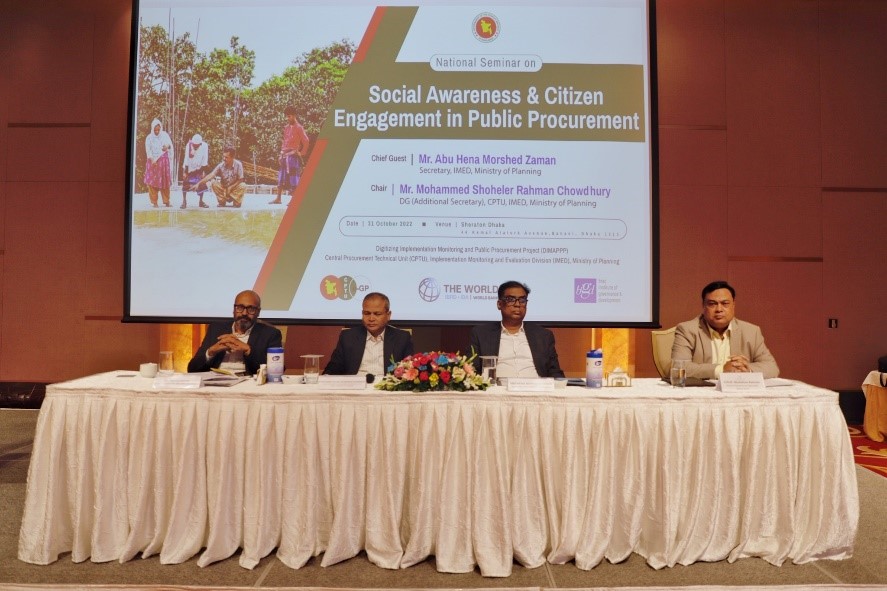
The Central Procurement Technical Unit (CPTU) organized a National Seminar on Social Awareness and Citizen Engagement in Public Procurement at Hotel Sheraton Dhaka on 31 October 2022 with the relevant public and private stakeholders. The seminar aimed to disseminate the findings and lessons learned through the implementation of three different but interrelated citizen engagement components under the “Digitizing Implementation Monitoring and Public Procurement Project (DIMAPPP)”. In this seminar, BCCP made a presentation to share the BCC activities implemented through this project as well as lessons learned. The stakeholders were actively engaged in discussion and provided dynamic suggestions for future planning.
 Mr. Abu Hena Morshed Zaman, Secretary, Implementation Monitoring and Evaluation Division (IMED), Ministry of Planning graced the event as the Chief Guest and the event was chaired by Mr. Mohammed Shoheler Rahman Chowdhury, Director General (Additional Secretary) CPTU, IMED, Ministry of Planning.
Mr. Abu Hena Morshed Zaman, Secretary, Implementation Monitoring and Evaluation Division (IMED), Ministry of Planning graced the event as the Chief Guest and the event was chaired by Mr. Mohammed Shoheler Rahman Chowdhury, Director General (Additional Secretary) CPTU, IMED, Ministry of Planning.
Abu Hena Morshed Zaman, secretary of IMED, present at the event as chief guest, said, "Bangladesh, with the great steering force of CPTU, has created a dynamic space for citizen engagement, democratising public sector processes. This shift represents a deep change in bureaucracy, transforming the government into an interconnected, modern organism that can evolve with changing times." Mustafizur Rahman of the World Bank said, "If media and citizens continue to know about and take interest in how the government spends its public funds, there will be greater social accountability, local needs are more likely to be met, the quality of public service delivery will improve, and the overall wellbeing of citizens will go up."
CPTU Director General, Mohammed Shoheler Rahman Chowdhury, in his concluding remarks at the event said, "Reversals can happen at any time, given the complex and charged political economy environment surrounding procurement, and that is why sustaining political support is so essential. We hope this seminar will help CPTU build a regulated structure to enhance citizen engagement in the public procurement process, to sustain and support improvements in public service delivery for our citizens."
e-GP earns tenderers’ faith Brings a lakh on the list; Tk 2,000cr in exchequer
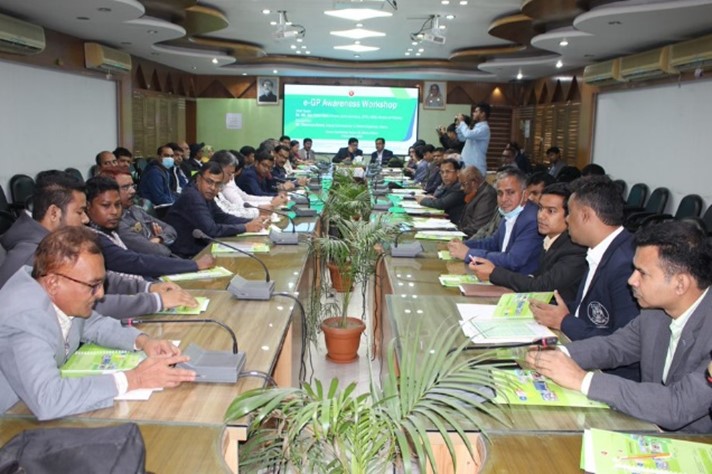 An e-GP (electronic government procurement) awareness workshop was held in Natore on December 08, 2022, aiming at ensuring transparency in public procurement for sustainable development in the country. The Central Procurement Technical Unit (CPTU) under the Implementation Monitoring and Evaluation Division (IMED) of the Ministry of Planning of the Government of the People's Republic of Bangladesh and Bangladesh Center for Communication Programs (BCCP) organized the workshop at the conference room of the office of Deputy Commissioner in the district.
An e-GP (electronic government procurement) awareness workshop was held in Natore on December 08, 2022, aiming at ensuring transparency in public procurement for sustainable development in the country. The Central Procurement Technical Unit (CPTU) under the Implementation Monitoring and Evaluation Division (IMED) of the Ministry of Planning of the Government of the People's Republic of Bangladesh and Bangladesh Center for Communication Programs (BCCP) organized the workshop at the conference room of the office of Deputy Commissioner in the district.
Md. Aziz Taher Khan, Director (Joint Secretary), CPTU, IMED, Ministry of Planning spoke as the chief guest at the workshop chaired by Shameem Ahmed, Deputy Commissioner & District Magistrate, Natore.
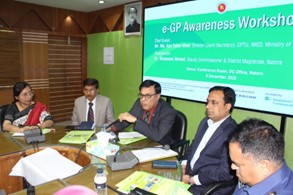 During a long and lively discussion, the participants, especially tenders, bankers and journalists made various queries and recommendations on the e-GP system where CPTU high officials and Procuring Entities (PEs) replied to clarify those and assured of incorporating valid recommendations received from the discussions.
At the beginning of the workshop, Dr. Zeenat Sultana, Program Director, BCCP delivered welcome address and made elaborate discussion on Citizen Portal and its effectiveness to make e-GP much popular among the people of all strata. Citizen Portal will effectively engage citizens in the process of monitoring project implementation works at grassroots levels which will ultimately contribute to quality and sustainable development in the country and reduce corruption, she noted.
During a long and lively discussion, the participants, especially tenders, bankers and journalists made various queries and recommendations on the e-GP system where CPTU high officials and Procuring Entities (PEs) replied to clarify those and assured of incorporating valid recommendations received from the discussions.
At the beginning of the workshop, Dr. Zeenat Sultana, Program Director, BCCP delivered welcome address and made elaborate discussion on Citizen Portal and its effectiveness to make e-GP much popular among the people of all strata. Citizen Portal will effectively engage citizens in the process of monitoring project implementation works at grassroots levels which will ultimately contribute to quality and sustainable development in the country and reduce corruption, she noted.
Citing about various methods incorporated by CPTU within the e-GP system for ensuring complete digitization, Md. Aziz Taher Khan said, the e-GP system has become much popular among tenderers for its convenient features and as a result over one lakh tenderers have been listed on the system and more than 6.36 lakh tenders have been invited and evaluated through e-GP since its inception in 2011. A total of Tk 2,000 crore has been deposited with the national exchequer as registration, renewal and tender document fees, he mentioned adding, so far, 27,713 e-GP users have been given trainings. 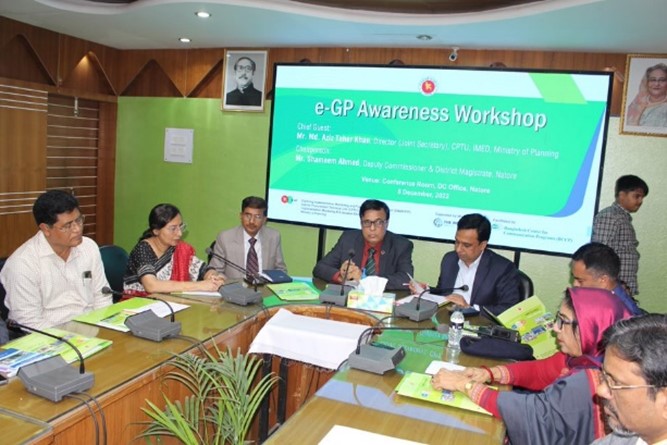 Meher Afroze, Deputy Director, BCCP made a presentation on e-GP at the workshop moderated by Md. Abdus Salam, Program Manager, BCCP.
Meher Afroze, Deputy Director, BCCP made a presentation on e-GP at the workshop moderated by Md. Abdus Salam, Program Manager, BCCP.
A total of 71 participants including representatives of procuring entities, tenderers, bankers, and journalists spoke at the workshop.
Stakeholder engagement on public procurement system initiated as the DIMAPP Project gets kick-off: CPTU-BCCP inception meet held
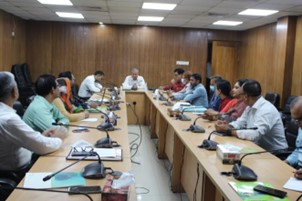 An inception meeting was held between the Central Procurement Technical Unit (CPTU) and the Bangladesh Center for Communication Programs (BCCP) on November 06, 2022, in the CPTU Conference Room to discuss action plan for implementation of the activities proposed under the services of Contract Package # CPTU/AF S-04 on Communication Consultant (Phase 2) under Digitizing Implementation Monitoring and Public Procurement Project (DIMAPPP).
An inception meeting was held between the Central Procurement Technical Unit (CPTU) and the Bangladesh Center for Communication Programs (BCCP) on November 06, 2022, in the CPTU Conference Room to discuss action plan for implementation of the activities proposed under the services of Contract Package # CPTU/AF S-04 on Communication Consultant (Phase 2) under Digitizing Implementation Monitoring and Public Procurement Project (DIMAPPP).
The meeting was graced with the presence of Mr. Mohammed Shoheler Rahman Chowdhury, Director General (Additional Secretary), CPTU, IMED, Ministry of Planning. Joint Secretaries and Directors of CPTU Mr. Md. Aziz Taher Khan, Mr. Md Shamimul Haque, Mr. Md Aknur Rahman PhD, Mr. Nasimur Rahman Sharif, Senior System Analyst Mr. Mosharraf Hussain and Director (Deputy Secretary) Ms. Laboni Chakma attended the meeting.
Dr Zeenat Sultana, Programme Director of BCCP, made a presentation on its plan to execute the one-year assignment. All members of the BCCP team under the assignment were present in the meeting.
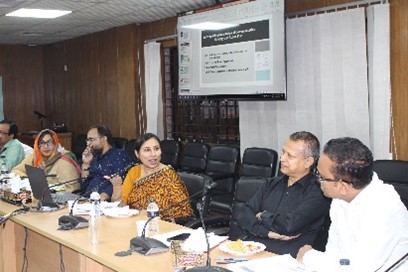 Mr. Hafiz al Mamun from the World Bank also attended the meeting. The BCCP will now submit a revised inception report as per suggestions made in the meeting in a week.
Mr. Hafiz al Mamun from the World Bank also attended the meeting. The BCCP will now submit a revised inception report as per suggestions made in the meeting in a week.
BTCRN Members Reiterated Their Commitments for Tobacco Control Research in Bangladesh
Bangladesh Tobacco Control Research Network (BTCRN) has been established by the Bangladesh Center for Communication with funding support from the Bloomberg Initiative through the Institute for Global Tobacco Control based at the Johns Hopkins Bloomberg School of Public Health, Baltimore, USA. The network's purpose is to promote tobacco control research in Bangladesh and create a nurturing culture for such research. Since its inception officially in 2016, the network has been working to contribute to generating local evidence-based in tobacco control in Bangladesh.
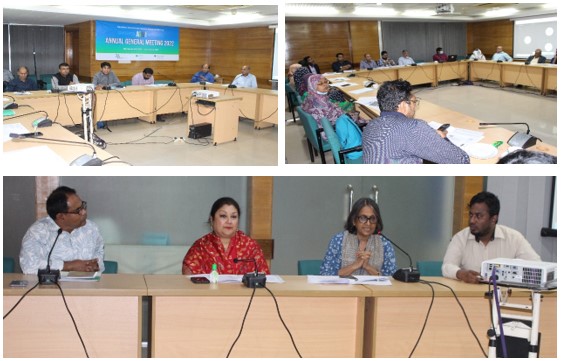
An Annual General Meeting (AGM) was held on 25th November 2022 at the Multipurpose Hall of BTRF. Prof. Dr. Nawzia Yasmin, President of the network, who is also the Pro Vice Chancellor of the State University of Bangladesh, presided over the meeting. An activity report of the network was read out by Mr. Mohammad Shamimul Islam, General Secretary of the network. During the open discussion, the members reiterated their commitment to promoting tobacco control research in Bangladesh. The members came to an agreement that BTCRN needed to be more vibrant in terms of promoting the research findings to be conducted by their members through different media including Facebook, Twitter, LinkedIn, and YouTube. It decided that a small group comprising the senior researchers of the network will be formed to provide input and support to the young researchers for publishing their journal articles.
At the end of the meeting, the members unanimously decided that the current Executive Committee will continue their roles and responsibilities for another two years.
“Awareness of the Rohingya people to use the service facilities with care is very important”
Mr. Mohammad Mizanur RahmanRefugee Relief and Repatriation Commissioner
Office of RRRC, Cox’s Bazar
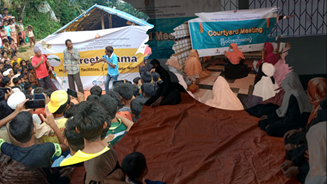 Bangladesh Center for Communication Programs, BCCP is providing consultancy services on “Communication and Awareness” activities to the “Local Government Engineering Division (LGED)” for “Emergency Multi-Sector Rohingya Crisis Response Project (EMCRP)” at Rohingya cams and host community of Cox’s Bazar, funded by the World Bank (WB). BCCP is providing support to bring behavioral change among the target group through several awareness building activities under the project. The “Round Table Discussion” and the “Photo Exhibition” and “Media Visit” was a part of many other communication activities during October to December 2022.
Bangladesh Center for Communication Programs, BCCP is providing consultancy services on “Communication and Awareness” activities to the “Local Government Engineering Division (LGED)” for “Emergency Multi-Sector Rohingya Crisis Response Project (EMCRP)” at Rohingya cams and host community of Cox’s Bazar, funded by the World Bank (WB). BCCP is providing support to bring behavioral change among the target group through several awareness building activities under the project. The “Round Table Discussion” and the “Photo Exhibition” and “Media Visit” was a part of many other communication activities during October to December 2022.
• Round Table Discussion:
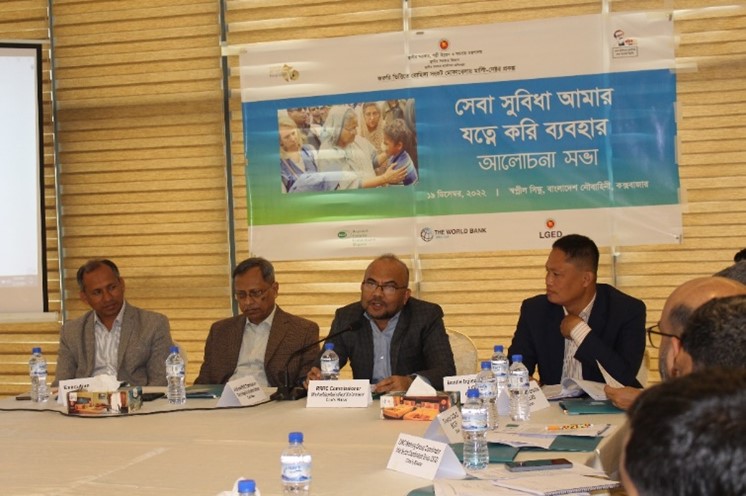 A round table discussion titled “Infrastructure Service Facilities: Use and Care” was arranged in Cox’s Bazar district, at the “Shopnil Sindhu conference hall of Bangladesh NAVY”, on December 19, 2022. The purpose of arranging the session was to inform the concerned key stakeholders about the implementation of EMCRP Project by LGED/GoB, receive feedback and clarify any issue(s) raised by the participants, and to articulate recommendations for effective implementation of EMCRP activities. Mr. Mohammed Mizanur Rahman, Commissioner, Refugee Relief and Repatriation Office, inaugurated the session as the chief guest. Mr. Prati Pada Dewan, Executive Engineer (CC), LGED, chaired the session where Mr. Mohammad Shahjahan, CEO, BCCP conveyed the welcome address. Mr. Mohammad Shamsuddouza, Additional Commissioner, Refugee Relief and Repatriation Office; Mostafizur Rahman Mostafa, Executive Engineer, Directorate of Public Health Engineering; Hasim Reza, Communication Specialist, LGED-MDSP; Mehbub Alam Barno, Communication Specialist, LGED-EMCRP; and Mr. Shafiqul Kabir, DDCL Field Residence Engineer, The World Bank was present as the special guests of the round-table session. A total of 44 participants of different stakeholders, that includes representatives from RRRC, LGED, South Forest Division, Fire Service & Civil Defense, BRAC, DDCL, SARPV, many other NGOs and INGOs, Journalists, Media, people attended the session conducted by Mr. Abu Hasib Mostafa Jamal, Deputy Director (Program), BCCP and Acting Team Leader for CAS/EMCRP/BCCP.
A round table discussion titled “Infrastructure Service Facilities: Use and Care” was arranged in Cox’s Bazar district, at the “Shopnil Sindhu conference hall of Bangladesh NAVY”, on December 19, 2022. The purpose of arranging the session was to inform the concerned key stakeholders about the implementation of EMCRP Project by LGED/GoB, receive feedback and clarify any issue(s) raised by the participants, and to articulate recommendations for effective implementation of EMCRP activities. Mr. Mohammed Mizanur Rahman, Commissioner, Refugee Relief and Repatriation Office, inaugurated the session as the chief guest. Mr. Prati Pada Dewan, Executive Engineer (CC), LGED, chaired the session where Mr. Mohammad Shahjahan, CEO, BCCP conveyed the welcome address. Mr. Mohammad Shamsuddouza, Additional Commissioner, Refugee Relief and Repatriation Office; Mostafizur Rahman Mostafa, Executive Engineer, Directorate of Public Health Engineering; Hasim Reza, Communication Specialist, LGED-MDSP; Mehbub Alam Barno, Communication Specialist, LGED-EMCRP; and Mr. Shafiqul Kabir, DDCL Field Residence Engineer, The World Bank was present as the special guests of the round-table session. A total of 44 participants of different stakeholders, that includes representatives from RRRC, LGED, South Forest Division, Fire Service & Civil Defense, BRAC, DDCL, SARPV, many other NGOs and INGOs, Journalists, Media, people attended the session conducted by Mr. Abu Hasib Mostafa Jamal, Deputy Director (Program), BCCP and Acting Team Leader for CAS/EMCRP/BCCP.
Refugee Relief and Repatriation Commissioner Mr. Mohammad Mizanur Rahman said, "Infrastructures construction in the Rohingya camps are continuing. All these infrastructures are very important. As roads are a must for transportation, LGED has constructed sustainable roads to facilitate the movement of the Rohingya people. Shelters are provided to protect them from natural disasters. Apart from this, solar lights have been installed, so that there is no difficulty in movement at night. In short, a lot of work has been done targeting the Rohingya camps. But the Rohingya people are not very conscious about the maintenance of these infrastructures. Some of them steal the solar lights to create an insecure atmosphere there in the darkness of night.
“Awareness of the Rohingya people to use the service facilities with care and creating their ownership to use the service facilities is very important. As the language, culture and behavior of Rohingya people is different so communication activities for them are is very challenging, thanks to the CAS/EMCRP/BCCP team involved for doing this” he added.
Mr. Pratipada Dewan, Executive Engineer, Directorate of Local Government Engineering said, “LGED works in three sectors to achieve economic growth in the country by constructing infrastructure facilities. These three sectors are: rural development, small scale water resource development and urban development. LGED is developing through various government projects to keep the roads functioning. We have set up various local and Rohingya camp-based infrastructures through EMCRP/LGED with financial assistance from the World Bank. We are building shelters to protect people from natural disasters. Some work has been completed while some is ongoing. Along with using these facilities, maintenance is everyone's responsibility. And BCCP, communication team of the EMCRP project has given significant support to improve the awareness of beneficiaries in these cases. Because of them, communication with the host and Rohingya population has become possible. For that, I sincerely thank them. I would request stockholders who are working in Rohingya camps, to cooperate with CAS team BCCP of EMCRP”.
Mohammad Shahjahan, Director and CEO of Bangladesh Center for Communication Programs (BCCP) said, “We have been providing communication services in Bangladesh for the social development sector for the last 26 years. We work in coordination with the government and private organizations. BCCP is trying to secure the process by gathering people's opinions on these issues including changing the social context. It makes human communication clearer and easier to understand. This is how BCCP works in public interest”.
LGED communication specialist Mr. Hasim Reza said, 'Communication system has made people's lives much easier. Since many the Rohingya people came to our country, I was thinking about various problems at first. But after developing an effective communication strategy, reaching and understanding them was not that difficult. Media has played an important role in creating a positive impact on people about them. So, to know something properly, communication media needs to be developed correctly, which BCCP does”.
Other participants, including the government representatives and the non-governmental organizations were also present and actively participated in the discussion. After the session, they visited the photo exhibition point and wrote comments on them.
• Photo Exhibition:
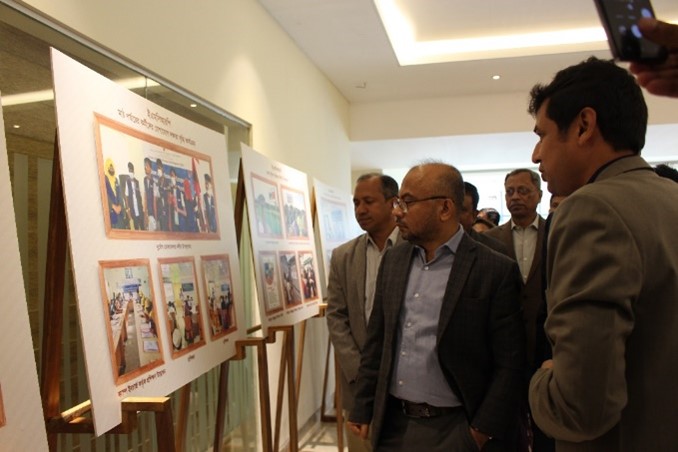 Following the round table discussion, a well decorated and attractive photo exhibition session was arranged on the location. It was a two-days program, inaugurated by Mr. Mohammed Mizanur Rahman, Commissioner, Refugee Relief and Repatriation Office, Cox’ Bazar. The exhibition was arranged to showcase the Rohingya crisis intervention activities in Bangladesh, initiated by EMCRP (LGED). Beyond EMCRP, some other organization like SARPV, Mukti, NGO Forum and SKUS - that works in Rohingya Crisis Response participated in the exhibition and shared their initiatives in support to overcome the crisis of the displaced Rohingya people. “Certificate of appreciation” signed by the Project Director, EMCRP and Director & CEO, BCCP was given among the participating organization as a recognition for their support.
Following the round table discussion, a well decorated and attractive photo exhibition session was arranged on the location. It was a two-days program, inaugurated by Mr. Mohammed Mizanur Rahman, Commissioner, Refugee Relief and Repatriation Office, Cox’ Bazar. The exhibition was arranged to showcase the Rohingya crisis intervention activities in Bangladesh, initiated by EMCRP (LGED). Beyond EMCRP, some other organization like SARPV, Mukti, NGO Forum and SKUS - that works in Rohingya Crisis Response participated in the exhibition and shared their initiatives in support to overcome the crisis of the displaced Rohingya people. “Certificate of appreciation” signed by the Project Director, EMCRP and Director & CEO, BCCP was given among the participating organization as a recognition for their support. 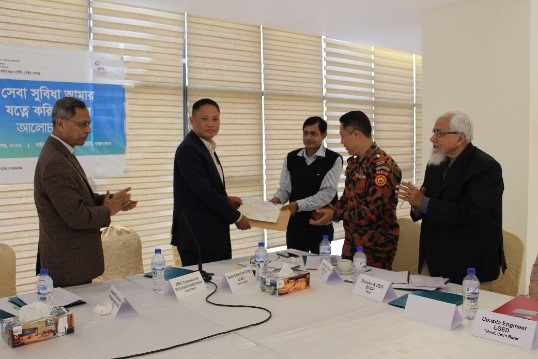 The government of the People's Republic of Bangladesh is providing various facilities to the local people and the Rohingya people (Forcibly Displaced Myanmar Nationals-FDMN), living in Ukhiya and Teknaf upazila of Cox's Bazar district. These facilities are given to support protect the overall quality of life of FDMN and host people. The beneficiaries people need to use these services with care. For this BCCP is working with the support from EMCRP/LGED.
The government of the People's Republic of Bangladesh is providing various facilities to the local people and the Rohingya people (Forcibly Displaced Myanmar Nationals-FDMN), living in Ukhiya and Teknaf upazila of Cox's Bazar district. These facilities are given to support protect the overall quality of life of FDMN and host people. The beneficiaries people need to use these services with care. For this BCCP is working with the support from EMCRP/LGED.
• Media visit:
For mobilizing the media and informing them about EMCRP project, organized a media visit for the local and national level Journalists from electronic, print, and online medias. Objectives of arranging the visits is to share the EMCRP activities to the Journalists/Reports and generate their interested on the progress and its impacts on the target population; motivate the Journalist/Reporters to collect success stories on EMCRP actives and share/publish/create report on the media.
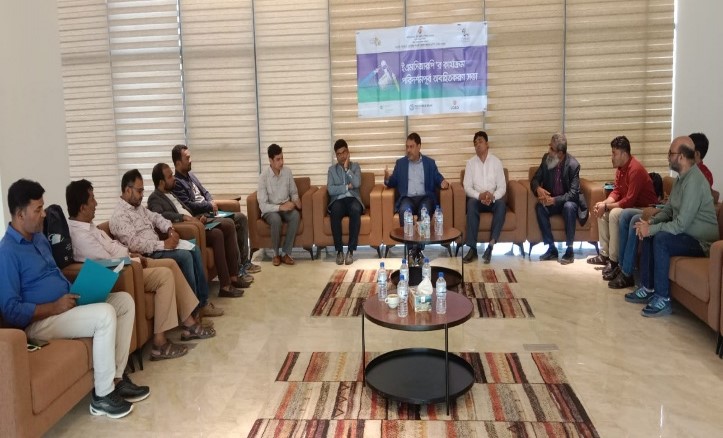 A brief discussion with journalists of print, electronic and social media was held on 14th December 2022 in the conference room of the Shopnil Shindhu before initiating the four days field visit. BCCP organized and facilitated the meeting participated by 16 members including the Executive Engineer-LGED, Upzala Engineer, LGED, Ukhya, and Teknaf, PMU EMCRP officials and journalist of electric & print and social media like: The Daily Ittefaq, The Daily Sun, Bangladesh Pratidin, Ajker Deshbidesh, Risingbd, Daily Protidiner Sangbad, Channel I, Ekushey TV, NTV, Cox’s Bazar voice and BD world. The event was moderated by Abu Hasib Mostofa Jamal, Deputy Director (Program),BCCP.
A brief discussion with journalists of print, electronic and social media was held on 14th December 2022 in the conference room of the Shopnil Shindhu before initiating the four days field visit. BCCP organized and facilitated the meeting participated by 16 members including the Executive Engineer-LGED, Upzala Engineer, LGED, Ukhya, and Teknaf, PMU EMCRP officials and journalist of electric & print and social media like: The Daily Ittefaq, The Daily Sun, Bangladesh Pratidin, Ajker Deshbidesh, Risingbd, Daily Protidiner Sangbad, Channel I, Ekushey TV, NTV, Cox’s Bazar voice and BD world. The event was moderated by Abu Hasib Mostofa Jamal, Deputy Director (Program),BCCP.
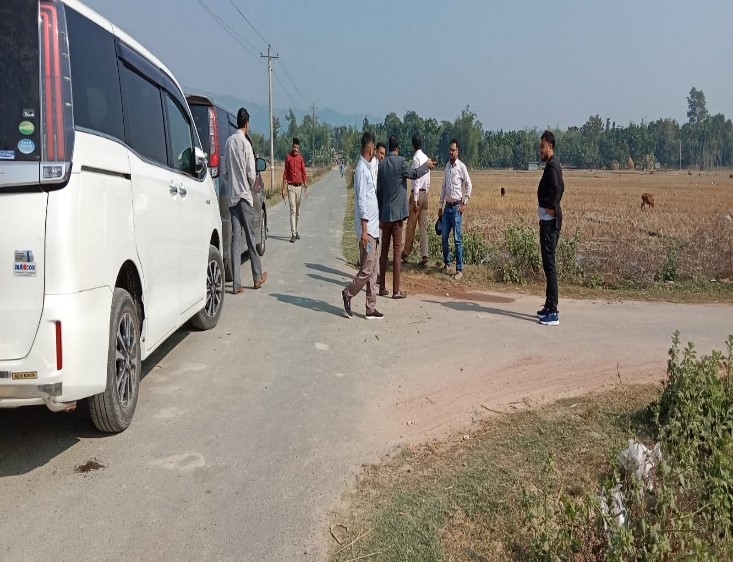 The Chairperson of the meeting has presented the overall goal and outcome of the EMCRP project funded by the World Bank. The project activities included construction of infrastructures like road, bridge, culvert, school cum cyclone shelters, warehouse for firefighting equipment, construction of Hat-Bazer, solar street light, community service center etc. These facilities are enjoying FDMN and host people. He also put emphasized that if these infrastructures are utilized properly by the community, those will be sustainable in future. BCCP has worked in increasing their awareness on this.
The media personnel were visited EMCRP activities in camps and host has asked various questions regarding this project during this visit and the concern LGED officials answered their questions.
The Chairperson of the meeting has presented the overall goal and outcome of the EMCRP project funded by the World Bank. The project activities included construction of infrastructures like road, bridge, culvert, school cum cyclone shelters, warehouse for firefighting equipment, construction of Hat-Bazer, solar street light, community service center etc. These facilities are enjoying FDMN and host people. He also put emphasized that if these infrastructures are utilized properly by the community, those will be sustainable in future. BCCP has worked in increasing their awareness on this.
The media personnel were visited EMCRP activities in camps and host has asked various questions regarding this project during this visit and the concern LGED officials answered their questions.
• Discussion with the Press:
On December 20, 2022 a discussion was held titled “Infrastructure Service Facilities: Use and Care” at the “Shopnil Sindhu conference hall of Bangladesh NAVY” Cox’s Bazar. The purpose of arranging the session was to showcase the effort of the Bangladesh Government through the EMCRP (LGED) project by highlighting the EMCRP activities and its services facilities and sharing the project's success to journalists/media people.
Abu Hasib Mostafa Jamal Deputy Director (Program), BCCP moderated the event while LGED Executive Engineer Mr. Pratipada Dewan was present as the chief guest. Hashim Reza, the communication specialist of LGED's MDSP, Shafiqul Kabir, field residence engineer of the DDCL/EMCRP, and Mehboob Alam Born, the communication specialist of LGED's EMCRP were present as special guests.
This effort of this project is to support the FDMN and effected host people of Cox’s Bazar by providing infrastructure service as well as to aware them to use these services with care. This project built up the interconnecting roads in camps and in the Ukhiya and Teknaf Upazila, schools come cyclone shelter centers, multipurpose community service centers, solar panels, and satellite fire stations for FDMN in camps and for host community under Cox’s Bazar. This project also priorities communication and awareness activities with is being conducted by BCCP.
Total 25 participants joined and interrogated many different areas regarding EMCRP. Engineers of EMCRP/LGED clarifies the technical issues and BCCP personnel informed them about the communication and awareness services for this project. All interrogations of journalists are gracefully answered by the respective proprietor. Eventually, the day ended up with an some nice words/complements from journalists.
After the media visit and discussion with press a huge number of news coverage has been provided, below is glimpses of those: -
- The Daily Star: https://www.thedailystar.net/news/bangladesh/news/govt-building-50-cyclone-shelters-3204456
- The Daily Sun: https://www.daily-sun.com/post/664174/Govt-building-50-multipurpose-cyclone-shelters-in-Teknaf-Ukhia
- The Daily Amadershomoy: https://www.dainikamadershomoy.com/post/414294
- The Bangladesh Protedin: https://www.bd-pratidin.com/country/2022/12/20/840670?fbclid=IwAR1lSHKGsjT8OU6G45IerPidSgliGfESXGiN1rIkYjPOgDJIYJbFaG-va_k
- The Daily Observer: https://www.observerbd.com/details.php?id=399067
- The Financial Express: https://today.thefinancialexpress.com.bd/metro-news/50-multipurpose-cyclone-shelters-being-constructed-in-teknaf-ukhia-1671900574
- The Bangladesh Post: https://www.bangladeshpost.net/posts/govt-building-50-multipurpose-cyclone-shelters-in-teknaf-ukhia-102111
- The Kalbela: https://kalbela.com/bangladesh/saradesh/v9l7g0odac?fbclid=IwAR1rQoBbLjPuQLViLpe315tE4KFoiVWWovFxcnZ221fDpHMqwI--nBrQxfc
- The BD World 24: http://bdworld24.net/archives/4271?fbclid=IwAR2HzicP6T-FsGtU05KRBOL_A5Y49bxEVD2UbIMJv_6j3hBHTS8dx4Co7JU
- The Businessinsider: https://www.businessinsiderbd.com/bangladesh/news/32420/govt-building-50-multipurpose-cyclone-shelters-in-teknaf-ukhia
- The Bangladesh Today: https://thebangladeshtoday.com/?p=53994
- The Business Post: https://businesspostbd.com/national/govt-building-50-multipurpose-cyclone-shelters-in-teknaf-ukhia
- The Daily Country Today: https://dailycountrytodaybd.com/story/govt-building-50-multipurpose-cyclone-shelters-in-teknaf,-ukhia
- The BSS: https://www.bssnews.net/news/101775
- The Sun news 24: https://www.sunnews24x7.com/news/article/bangladesh/75580?fbclid=IwAR0dtiW9Ws1oDLGNeKFcE28onvlBI3FB3q_kiMvbp0Q7dX6IzzHCyP4INR0
- The risingbd.com: https://www.risingbd.com/bangladesh/news/486886?fbclid=IwAR2Jmn0BwsHLdbIUKa1StMifRA9nNo0Q6s_O2Oy0Jc_FjoxySqZT0RSPMcc
- Protedener Sangbad: https://www.protidinersangbad.com/whole-country/372304
News story at social media: Cox’s Bazar Voice
- Cox’s Bazar Voice FB channel: রোহিঙ্গা ক্যাম্পে অবকাঠামো ও নিরাপদ পানি https://www.facebook.com/watch/?v=866027204612322&extid=CL-UNK-UNK-UNK-AN_GK0T-GK1C&mibextid=2Rb1fB&ref=sharing
- Cox’s Bazar Voice FB channel: উন্নয়ন দেখে খুশি রোহিঙ্গা ও স্থানীয় জনগোষ্ঠী https://www.facebook.com/watch/?extid=CL-UNK-UNK-UNK-AN_GK0T-GK1C&mibextid=2Rb1fB&v=1162840777707403
- Cox’s Bazar Voice FB channel: বদলে গেছে উখিয়ার গ্রামীণ জনপদ https://www.facebook.com/watch/?v=707391894150479&extid=CL-UNK-UNK-UNK-AN_GK0T-GK1C&mibextid=2Rb1fB&ref=sharing
- Cox’s Bazar Voice YouTube channel:রোহিঙ্গা ক্যাম্পে অবকাঠামো উন্নয়ন, নিরাপদ পানি ও বর্জ্য ব্যবস্থাপনা https://www.youtube.com/watch?v=GZ0kDbPDI3g
- Cox’s Bazar Voice YouTube channel: উন্নয়ন দেখে খুশি রোহিঙ্গা ও স্থানীয় জনগোষ্ঠী https://www.youtube.com/watch?v=w827s030Xww
- Cox’s Bazar Voice YouTube channel: বদলে গেছে উখিয়া-টেকনাফের গ্রামীণ জনপদ https://www.youtube.com/watch?v=YzI85lKAMDw
- BD World FB channel: উখিয়া টেকনাফে ইএমসিআরপি প্রকল্পের সড়ক ও যোগাযোগ ব্যবস্থার উন্নয়ন https://www.facebook.com/watch/?v=548227550295627
- BD World FB channel: উখিয়া-টেকনাফে ইএমসিআরপি প্রকল্পের অবকাঠামো নির্মাণ, নিরাপদ পানি ও বর্জ্য ব্যবস্থাপনা https://www.facebook.com/watch/?v=708556517284221
- BD World FB channel: ইএমসিআরপি প্রকল্পের মাধ্যমে উখিয়া-টেকনাফে জনসচেতনতা কার্যক্রম https://www.facebook.com/watch/?v=1158954164745935
- BD World YouTube channel: উখিয়া টেকনাফে ইএমসিআরপি প্রকল্পের সড়ক ও যোগাযোগ ব্যবস্থার উন্নয়ন https://www.youtube.com/watch?app=desktop&v=33MIqOpIheE&fbclid=IwAR2Cub0VYp2n36aM-3G2Bf-1--3tCZUcyxVRHjsZ-PXU41EAOeSzHMit5V0
- BD World YouTube channel: ইএমসিআরপি প্রকল্পের অবকাঠামো নির্মাণ, নিরাপদ পানি ও বর্জ্য ব্যবস্থাপনা https://www.youtube.com/watch?app=desktop&v=fy66HSwDOaw&fbclid=IwAR0NB7nG6C6wwcJHyksnCFY3nwPoDXiINRb72JqUvgziCBgSQEPM_9cf0Hg
- BD World YouTube channel: ইএমসিআরপি প্রকল্পের মাধ্যমে উখিয়া-টেকনাফে জনসচেতনতা কার্যক্রম https://www.youtube.com/watch?app=desktop&v=O0s7SVIJFdY&fbclid=IwAR3BU8TI9jh2Kx_-aVsbSDSl1NppBUqLpLvCwsL-0qHRrHkVnvI60ID_VKQ
Editorial
Combatting digital violence to women: more effort requires
Abusers using digitized medium often misuse technology as a way to control, monitor, and harass victims many of whom are women. Despite the severe implications of such harmful behavior of the abusers, it is frightening to see how attacks in the digital world to the women and girls often remain underreported and underestimated and the huge challenges that still lie along the path towards obtaining justice. With the increased participation of the women and girls in the societal development of the country they are now getting more exposed with internet and technologies. This is also exposed them with increased level of violence. Girl students, women workers and celebrities are increasingly engaged in the digital spheres to access and share information and they become vulnerable with digital violence.
The first step towards addressing violence against women and girls in the digital sphere is to recognize that this is yet another manifestation of gender-based violence that, like any other, hampers the full realization of gender equality and violates women’s and girls’ human rights. Putting an end to such violence, wherever it occurs and through whichever means it is commited, must be a priority issue. The digital dimension of violence against women, the ratification and adequate implementation of the law of the country, the most far-reaching legal instrument to prevent and combat violence against women and domestic violence, proves to be essential in today’s fast-moving times.
Ways abusers misuse technology includes; cyberstalking, electronic surveillance, abuse involving nude/sexual images, remain in disguise, online harassment, and more. Cyber-surveillance can be an effective way out that involves the use of connected to devices to monitor places or people. Connected technology could be used for own interest of women and girls. Cyber-surveillance is when a person uses “smart” or “connected” devices that communicate through a data network to monitor people or places. Devices may be connected through a home network, the Internet and WiFi, Bluetooth, or other means. These devices and systems offer tools that women can use to increase their own safety and convenience.
The digital dimension of violence against women and girls remains insufficiently addressed. Common shortcomings persist in most domestic laws adopted in this respect. In some countries, the issue is only partially tackled through the lens of children’s rights and Internet safety, while others only focus on certain forms of digital violence. The recognition and sanctioning of committing harm against women and girls online mostly focuses on ensuring the person’s safety, reputation or property. Failing to place it in the context of a continuum of violence affecting women and girls in all areas of life will impact on social, economic, psychological and participatory harm.
Scoop News: International Publications
Videos
BCCP PROMOTIONAL VIDEO

































